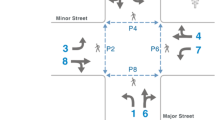Abstract
This study intends to investigate operational performance of the group-based signal control approach (GA) in Japan. A cycle-based stochastic approach incorporating the HCM 2000 delay model and Monte Carlo simulation was proposed. To facilitate its application, extensive field data was collected at 11 typical intersections in Germany and Japan to understand the variability of input variables and their correlations. A series of case studies were eventually conducted to investigate the applicability of GA under various conditions, i.e., degree of saturation (DS), split ratio (SR), and the coefficient of variation (COV) of traffic demand. Conclusions supported that the operational performance of GA deteriorated with increasing SR and decreasing DS. GA is apparently advantageous for SRs less than 0.8, COVs less than 0.2, and optimum cycle lengths greater than 90 s.







Similar content being viewed by others
Explore related subjects
Discover the latest articles, news and stories from top researchers in related subjects.References
Wong, C.K., Wong, S.C., Tong, C.O.: Optimization methods for off-line traffic signal settings: recent advances and prospective future research. J. Transp. Syst. Eng. Inf. Technol. 5, 36–54 (2005)
Bell Michael, G.H., Brookes, D.: Discrete time-adaptive traffic signal control: the calculation of expected delays and stops. Transp. Res. C 1C, 43–55 (1993)
Heydecker, B.G.: A decomposition approach for signal optimisation in road networks. Transp. Res. B 30, 99–114 (1996)
Wong, S.C., Wong, W.T., Leung, C.M., Tong, C.O.: Group-based optimization of a time-dependent TRANSYT traffic model for area traffic control. Transp. Res. B 36, 291–312 (2002)
Suzuki, K., Nakamura, H., Yamaguchi, S.: Analysis on drivers’ and pedestrians’ perception for the evaluation of cycle length at under-saturated signalized intersections. Proceedings of the 10th World Conference on Transport Research, Istanbul (2004)
Tang, K., Nakamura, H.: Impacts of group-based signal control policy on driver behavior and intersection safety. J. Int. Assoc. Traffic Saf. Sci. 32, 81–94 (2008)
Tang, K., Nakamura, H.: Safety evaluation for intergreen intervals at signalized intersections based on a probabilistic method. Transp. Res. Rec. 2128, 226–235 (2009)
Dion, F., Rakha, H., Kang, Y.: Comparison of delay estimates at under-saturated and over-saturated pre-timed signalized intersections. Transp. Res. B 38, 99–122 (2004)
Transportation Research Board, “Highway Capacity Manual 2000. National Research Council, Washington, DC (2000)
Akcelik, R.: Traffic Signals: Capacity and Timing Analysis. Australian Road Research Board, Melbourne (1998). Seventh reprint
Tarko, A., Songchitruksa, P.: Reporting uncertainty in the highway capacity manual-survey results. Proceedings of the 84th Annual Meeting of Transportation Research Board, Washington, D.C., (2003)
Tang, K., Nakamura, H.: An analysis on saturation flow rate and its variability. Proceedings of the 11th World Conference on Transport Research, Berkeley (2007)
Ji, X., Prevedouros, P.D.: Probabilistic analysis of highway capacity manual models: case study of a signalized intersection. Transp. Res. Rec. 2027, 58–64 (2007)
Viti, F., van Zuylen, H.J.: A probabilistic model for traffic at actuated control signals. Transp. Res. C 18, 299–310 (2010)
Park, B., Kamarajugadda, A.: Estimating confidence interval for highway manual delay equation at signalized intersections. Proceedings of the 84th Annual Meeting of the Transportation Research Board, Washington, D.C., (2003)
Tarko, A., Tian, Z.: Example analysis and handling of uncertainty in HCM with consideration of traffic diversion. Transp. Res. Rec. 1852, 40–46 (2003)
Luttinen, R.T.: Uncertainty in operational analysis of two-lane highways. Transp. Res. Rec. 1802, 105–114 (2002)
Khatib, Z., Kyte, M.: Framework to uncertainty in projecting the level of service of signalized and unsignalized intersections. Transportation Research Circular. E-C018. 348-356 (2000)
Ji, X., Prevedouros, P.D.: Comparison of methods for sensitivity and uncertainty analysis of signalized intersections analyzed with HCM 2000. Transp. Res. Rec. 1920, 56–64 (2005)
Ji, X., Prevedouros, P.D.: Probabilistic analysis of Highway Capacity Manual delay for signalized intersections. Transp. Res. Rec. 1988, 67-75 (2005)
Brilon, W., Geistefeldt, J., Zurlinden, H.: Implementing the concept of reliability for highway capacity analysis. Transp. Res. Rec. 2027, 1–8 (2007)
Acknowledgments
The authors would like to convey their sincere thanks to Prof. Manfred Boltze of Darmstadt University of Technology and Dr. Axel Wolfermann of Nagoya University, for their great support in data collection and valuable comments on this research.
Author information
Authors and Affiliations
Corresponding authors
Rights and permissions
About this article
Cite this article
Tang, K., Nakamura, H. Investigating Operational Benefits of Group-based Signal Control in Japan Through a Stochastic Approach. Int. J. ITS Res. 9, 71–81 (2011). https://doi.org/10.1007/s13177-011-0028-y
Received:
Revised:
Accepted:
Published:
Issue Date:
DOI: https://doi.org/10.1007/s13177-011-0028-y




